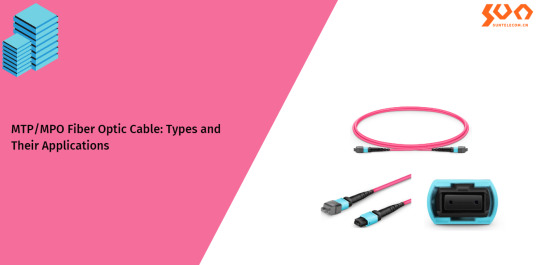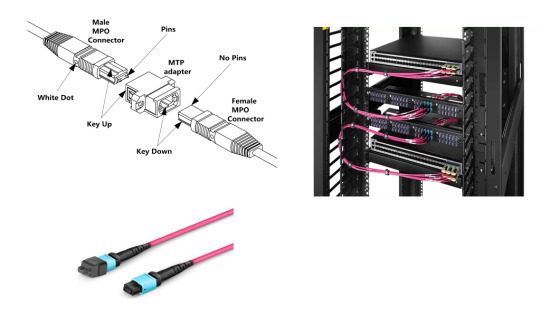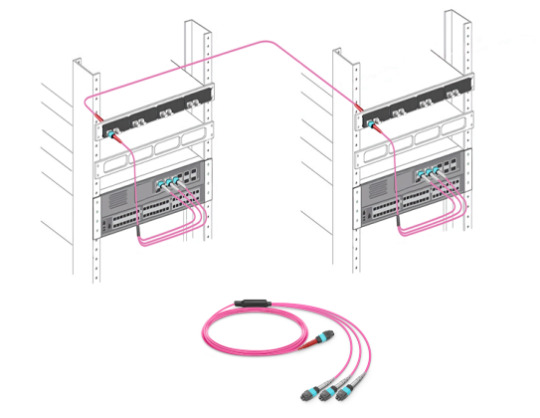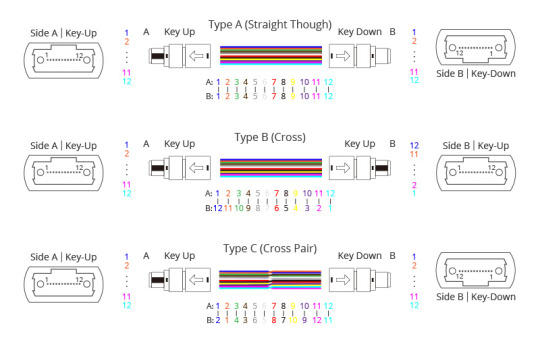#MPoS Terminals Market
Text
#North America Mpos Terminals Market Growth 2023 Top Countries Data#Future Demand#Market Trends#Opportunity and Industry Report#2031
0 notes
Link
0 notes
Text
MTP/MPO Fiber Optic Cable: Types and Their Applications
With ever-greater bandwidths and network connections to deal with in data centers, traditional duplex fiber patch cords like LC fiber patch cords no longer meet the demands. To solve this issue, MTP/MPO fiber optic cable that houses more fibers in a multi-fiber MTP/MPO connector was introduced in the market as a practical solution for 40G/100G/400G high-density cabling in data centers. This article will introduce different MTP/MPO cable types and their applications.

What is MTP/MPO Cable?
MPO (multi-fiber push-on) is the first generation of clip-clamping multi-core fiber optic connectors. MTP is an advanced version of MPO with the better mechanical and optical performance. They look similar and are fully compatible and interchangeable.

MTP/MPO cable consists of MTP/MPO connector and optical fiber. MTP/MPO connector has a female type (without pins) or a male type (with pins). MTP/MPO connector increases the fiber optic cable density and saves circuit card and rack space, which is well suited for current data center cabling and future network speed upgrades.

MTP/MPO Cable Types
MTP/MPO cable types are classified based on function, polarity, fiber count, fiber mode, and jacket rating.
By Function
Based on function, MPO/MTP cable type is divided into MTP/MPO trunk cable, MTP/MPO breakout cable, and MTP/MPO conversion cable.
MTP/MPO Trunk Cable
MTP/MPO trunk cable is terminated with an MTP/MPO connector (female/male) on both ends, which is available in 8-144 fiber counts for users’ choices. Typically, MTP/MPO trunk cable is ideal for creating a structured cabling system, including backbone and horizontal interconnections such as 40G-40G and 100G-100G direct connections.

2.MTP/MPO Breakout Cable
MTP/MPO breakout cable (aka. harness cable or fanout cable) is terminated with a female/male MTP/MPO connector on one end and 4/6/8/12 duplex LC/FC/SC/ST connectors on the other end, such as 8-fiber MTP/MPO to 4 LC harness cables and 12-fiber MTP/MPO to 6 LC harness cables. Typically, MTP/MPO breakout cable is ideal for short-range 10G-40G and 25G-100G direct connections or for connecting backbone assemblies to a rack system in the high-density backbone cabling.

3.MTP/MPO Conversion Cable
MTP/MPO conversion cable has the same fanout design as MTP/MPO breakout cable but is different in fiber counts and types. MTP/MPO conversion cable is terminated with MTP/MPO connectors on both ends. MTP/MPO conversion cable is available in 24-fiber to 2×12-fiber, 24-fiber to 3×8-fiber, and 2×12-fiber to 3×8-fiber types, and is ideal for 10G-40G, 40G-40G, 40G-100G, and 40G-120G connections, which eliminate fiber wasting and largely increase the flexibility of the MTP/MPO cabling system.

By Polarity
Polarity refers to the difference between the optical transmitters and receivers at both ends of the fiber link. Due to the special design of MTP/MPO connectors, polarity issues must be addressed in high-density MTP/MPO cabling systems. To guarantee the correct polarity of the optical path, the TIA 568 standard defines three connection methods, called Type A, Type B, and Type C. The cables of the three MTP/MPO connector types have different structures.

By Fiber Count
Based on fiber count, MTP/MPO cable type is divided into 8/12/16/24 fiber. The 8-fiber MTP/MPO cable can transmit the same data rate as 12-fiber, but with lower cost and insertion loss, making it a more cost-effective solution. 12-fiber MTP/MPO cable is the earliest developed and most commonly used solution in 10G-40G and 40G-100G connections. If it is used in 40G QSFP+ or 100G QSFP28 transceivers, 4 fibers will be idle, resulting in low fiber utilization.16-fiber MTP/MPO is designed for 800G QSFP-DD/OSFP DR8 and 800G OSFP XDR8 optics direct connection and supporting 800G transmission for hyperscale data center. 24-fiber fiber MTP/MPO cable is used to establish a 100GBASE-SR10 connection or 400G connection between CFP and CFP transceivers.

By Fiber Mode
Based on fiber mode, MTP/MPO cable includes single-mode (SM) and multi-mode (MM). SM MTP/MPO cable is suitable for long-distance transmissions, such as in metropolitan area networks (MANs) and passive optical networks PONs (PONs), with less modal dispersion, and it is available in OS2 type. While MM MTP/MPO cable is suitable for short-distance transmission, allowing 40 Git/s maximum transmission distance of 100m or 150m, and it is available in OM3/OM4 types.

By Jacket Rating
According to different fire rating requirements, the jackets of MTP/MPO cable types are divided into low smoke zero halogen (LSZH), optical fiber non-conductive plenum (OFNP), communications multipurpose cable plenum (CMP), etc. LSZH MTP/MPO cable is free of halogenated materials (toxic and corrosive during combustion), provides better protection for personnel and equipment in a fire, and is suitable for closed places. OFNP MTP/MPO cable contains no electrically conductive elements and is designed with the highest fire rating, which can be installed in ducts, plenums, and other spaces for building airflow. CMP MTP/MPO cable can restrict flame propagation and smoke exhaust rate during a fire, which is suitable for plenum spaces, where air circulation for heating and air conditioning systems are facilitated.
Conclusion
MTP/MPO cables provide stable transmission, high performance, high-density cabling for various environments, and prevent network bottlenecks, reduce network latency, and expand bandwidth and scalability for future network expansion. Sun Telecom provides total and customized solutions of fiber optic products to the global market. Contact us if you have any needs.
2 notes
·
View notes
Text
https://synkretic.mn.co/posts/mobile-point-of-sale-mpos-terminals-market-future-demand-business-strategies-different-segments-opportunities-regional-outlook-and-forecast
0 notes
Text
0 notes
Text
0 notes
Text
What are the different types of POS Software?

In today’s fast-paced retail and hospitality environments, efficient and reliable Point of Sale (POS) software is essential for smooth operations. POS software is the backbone of any business transaction, helping to streamline sales processes, manage inventory, and provide valuable insights through data analytics. There are several types of POS software, each tailored to meet the specific needs of different businesses. This blog will explore the various types of POS software, highlighting their unique features and benefits.
1. Traditional POS Systems
On-Premise POS
On-premise POS systems are the traditional form of POS software, where the system is installed directly on the business’s hardware, usually a computer or a dedicated POS terminal. These systems are typically used by larger businesses with a fixed location and substantial daily transactions.
Pros:
Greater control over the system
Customizable to specific business needs
High data security as data is stored locally
Cons:
Higher initial cost for hardware and software
Requires in-house IT support for maintenance and updates
Limited accessibility as data can only be accessed on-site
2. Cloud-Based POS Systems
Cloud-based POS systems, also known as web-based or online POS, are hosted on remote servers and accessed through the internet. This type of system is gaining popularity due to its flexibility and ease of use.
Pros:
Lower upfront costs as there is no need for expensive hardware
Accessible from any device with an internet connection
Automatic updates and backups
Scalable to accommodate business growth
Cons:
Dependence on internet connectivity
Potential security concerns with data stored on external servers
Subscription-based model can lead to higher long-term costs
3. Mobile POS Systems
Mobile POS (mPOS) systems transform smartphones and tablets into portable POS terminals. These systems are ideal for businesses that require mobility, such as food trucks, market vendors, and pop-up shops.
Pros:
Highly portable and flexible
Lower cost compared to traditional POS systems
Easy to set up and use
Cons:
Limited functionality compared to full-fledged POS systems
Security concerns if devices are lost or stolen
Dependence on battery life and internet connectivity
4. Tablet POS Systems
Tablet POS systems are similar to mPOS but are specifically designed to run on tablets. They offer a good balance between the portability of mPOS and the functionality of traditional POS systems.
Pros:
User-friendly interface
Portable and versatile
Cost-effective solution for small to medium-sized businesses
Cons:
Limited processing power compared to desktop systems
Dependence on internet connectivity
Potential security vulnerabilities if not properly managed
5. Self-Service Kiosk POS Systems
Self-service kiosk POS systems allow customers to place orders and make payments independently, reducing the need for staff intervention. These systems are commonly used in quick-service restaurants, movie theaters, and retail stores.
Pros:
Enhances customer experience by reducing wait times
Increases order accuracy
Allows staff to focus on other tasks
Cons:
High initial setup cost
Requires regular maintenance
May require customer education on how to use the kiosks
6. Multichannel POS Systems
Multichannel POS systems are designed to integrate and manage sales across various channels, including physical stores, online shops, and mobile apps. This type of system is essential for businesses operating in multiple sales environments.
Pros:
Centralized management of inventory and sales data
Consistent customer experience across all channels
Improved inventory control and reporting
Cons:
Complex setup and integration
Higher cost due to advanced features
Requires robust IT support for maintenance and troubleshooting
7. Industry-Specific POS Systems
Industry-specific POS systems are tailored to meet the unique requirements of particular industries, such as restaurants, retail stores, and salons. These systems come with specialized features that cater to the specific needs of the business.
Pros:
Customized to industry-specific workflows
Includes relevant features like table management for restaurants or appointment scheduling for salons
Enhances operational efficiency
Cons:
Limited flexibility for businesses outside the targeted industry
May be more expensive due to specialized features
Requires industry-specific knowledge for effective use
Choosing the right POS software is critical for the smooth operation and success of any business. Whether you opt for a traditional on-premise system, a flexible cloud-based solution, a mobile or tablet POS for portability, a self-service kiosk for customer convenience, a multichannel system for integrated sales management, or an industry-specific solution, understanding the unique features and benefits of each type will help you make an informed decision. By aligning the POS system with your business needs, you can streamline operations, enhance customer experience, and drive growth.
0 notes
Text
Fast Food and Quick Service Restaurant Market Developments, Trends & Opportunities till 2032
Fast Food and Quick Service Restaurant Market provides in-depth analysis of the market state of Fast Food and Quick Service Restaurant manufacturers, including best facts and figures, overview, definition, SWOT analysis, expert opinions, and the most current global developments. The research also calculates market size, price, revenue, cost structure, gross margin, sales, and market share, as well as forecasts and growth rates. The report assists in determining the revenue earned by the selling of this report and technology across different application areas.
Geographically, this report is segmented into several key regions, with sales, revenue, market share and growth Rate of Fast Food and Quick Service Restaurant in these regions till the forecast period
North America
Middle East and Africa
Asia-Pacific
South America
Europe
Key Attentions of Fast Food and Quick Service Restaurant Market Report:
The report offers a comprehensive and broad perspective on the global Fast Food and Quick Service Restaurant Market.
The market statistics represented in different Fast Food and Quick Service Restaurant segments offers complete industry picture.
Market growth drivers, challenges affecting the development of Fast Food and Quick Service Restaurant are analyzed in detail.
The report will help in the analysis of major competitive market scenario, market dynamics of Fast Food and Quick Service Restaurant.
Major stakeholders, key companies Fast Food and Quick Service Restaurant, investment feasibility and new market entrants study is offered.
Development scope of Fast Food and Quick Service Restaurant in each market segment is covered in this report. The macro and micro-economic factors affecting the Fast Food and Quick Service Restaurant Market
Advancement is elaborated in this report. The upstream and downstream components of Fast Food and Quick Service Restaurant and a comprehensive value chain are explained.
Browse More Details On This Report at @https://www.globalgrowthinsights.com/market-reports/fast-food-and-quick-service-restaurant-market-100554
Global Growth Insights
Web: https://www.globalgrowthinsights.com
Our Other Reports:
Liquid Laundry Detergent MarketMarket Growth Rate
Water Storage Systems MarketMarket Forecast
Global Online Taxi Service MarketMarket Size
Large-Scale LNG Terminals MarketMarket Growth
GBL and NMP MarketMarket Analysis
Direct Carrier Billing Platform MarketMarket Size
Global Kubernetes Solutions MarketMarket Share
Global Salesforce CRM Document Generation Software MarketMarket Growth
Incident Forensics MarketMarket
Contract Development and Manufacturing Organizations (CDMOs) MarketMarket Share
Cervical Total Disc Replacement Device MarketMarket Growth Rate
Medical Animation MarketMarket Forecast
Global Tax Management Software MarketMarket Size
Drone Camera MarketMarket Growth
MPO Fiber Optic Connector MarketMarket Analysis
Electroplating Chemicals MarketMarket Size
Global Isobutanol MarketMarket Share
Global Small Cell 5G Network MarketMarket Growth
Dry Strand Pelletizers MarketMarket
Aircraft Engine, Parts and Equipment MarketMarket Share
Fluorine Aromatic Pi Film MarketMarket Growth Rate
LNG As A Bunker Fuel MarketMarket Forecast
Global Winches MarketMarket Size
Veterinary Hematology Analyzers MarketMarket Growth
Apheresis Machines MarketMarket Analysis
Smart Rice Cooker MarketMarket Size
Global Airlaid Paper MarketMarket Share
Global LPG Metal Cylinders MarketMarket Growth
Container Weighing Systems MarketMarket
Virtual Reality Content MarketMarket Share
White Glove Services MarketMarket Growth Rate
Dive Scooter MarketMarket Forecast
Global Premium Motorcycle Helmet MarketMarket Size
Bicycle Pedal MarketMarket Growth
Plastic Sheets MarketMarket Analysis
Bus Air Suspension System Market Market Size
Global Electric Platform Carts Market Market Share
Global Paste PVC (PPVC) MarketMarket Growth
Well Drilling and Repairing Machinery MarketMarket
0 notes
Text
Why Choose MPO 12 Fiber Cable? FiberLife Tells You
In this era of data explosion, selecting the right network cabling solution has become a significant challenge for many businesses. As a global leader in fiber optic and integrated network solutions, FiberLife is dedicated to providing high-performance and innovative fiber optic connection solutions to private individuals, companies, operators, ISPs, content providers, and network research and development institutions. Today, we will delve into why the MPO 12 fiber cable is your best choice, helping you solve wiring challenges and improve network efficiency.
The Superiority of High-Density Connections
In modern data centers and enterprise network environments, the density and neatness of cabling are crucial factors. The MPO 12 fiber cable can accommodate 12 fibers in a single connector, providing a high-density connection solution in limited space. Compared to traditional single-fiber connections, the MPO 12 fiber cable significantly reduces the number of cables, saving space in cabinets and patch panels. This high-density connection not only makes the wiring in the equipment room more orderly and neat but also greatly facilitates later management and maintenance. Fewer cables mean fewer tangling and knotting issues, thereby improving the reliability and aesthetics of the network.

The Advantage of Quick Deployment
In the rapidly evolving tech environment, the need for network upgrades and expansions is increasing. The pre-terminated nature of the MPO 12 fiber cable makes it a plug-and-play solution that can be terminated and tested in the factory, requiring only simple connections on-site for immediate use. This rapid deployment method significantly shortens the cabling time, reducing downtime during network upgrades or expansions, thus ensuring business continuity. For enterprises that frequently need network modifications, quick deployment means a faster response to market changes, improving overall operational efficiency.

Ensuring High-Performance Transmission
With the explosive growth of data, the demand for network transmission speed and bandwidth is continuously increasing. The MPO 12 fiber cable supports both multimode and single-mode fibers, enabling high-speed data transmission to meet the demands of data centers and high-performance computing environments. Its high-quality MPO connectors and fiber design ensure low insertion loss and high return loss, enhancing network stability and reliability. Whether in big data processing or cloud computing applications, the MPO 12 fiber cable can provide stable and efficient transmission performance, offering users a seamless data experience.
Flexible Expansion Capability

Compatibility and Versatility

Conclusion
From the above analysis, it is clear that the MPO 12 fiber cable has significant advantages in high-density connection, quick deployment, high-performance transmission, flexible expansion, and compatibility. In today’s fast-paced information age, selecting the right fiber optic cable is crucial, and the MPO 12 fiber cable is the best choice to meet current network needs and provide a solid foundation for future upgrades and expansions.
If you are looking for an efficient, reliable, and flexible network cabling solution, consider FiberLife’s 12 Fibers Multimode OM1 12 Strands MPO-LC Harness Cable 3.0mm LSZH/Riser. This product not only boasts the high-density connection advantages of 12 multimode fibers but also offers quick deployment through the MPO-LC connector design, saving cabling time and maintenance costs. Whether for data centers or enterprise LANs, this fiber cable can provide stable and efficient transmission performance.
Choose FiberLife’s Custom MPO 12 fiber cable and make network cabling worry-free from now on!
FiberLife is committed to providing you with high-performance and innovative products, helping you easily tackle various network cabling challenges. Visit our website and choose this high-quality MPO 12 fiber cable to make your network cabling simpler and more efficient!
1 note
·
View note
Text
SwiftPay: Revolutionizing Retail with Mobile Point of Sale Devices (mPOS)
In today's fast-paced retail landscape, Mobile Point of Sale Devices (mPOS) are reshaping the way businesses conduct transactions and engage with customers.
Download PDF Sample Report@https://www.globalinsightservices.com/request-sample/GIS23825/?utm_source=SnehaP-Article
With SwiftPay, retailers can transform any smartphone or tablet into a portable, secure, and versatile point of sale terminal, empowering sales associates to process payments on the go. These devices offer flexibility and convenience, allowing businesses to extend their reach beyond traditional brick-and-mortar stores to pop-up shops, events, and outdoor markets. With features such as contactless payments, inventory management, and customer relationship management (CRM) integration, mPOS solutions streamline operations, reduce checkout times, and enhance the overall shopping experience. As the demand for omnichannel retail experiences continues to rise, SwiftPay emerges as a game-changer, enabling businesses to stay agile, competitive, and customer-centric in an ever-evolving market. #mPOS #MobilePayments #RetailTech #Omnichannel #PointofSale #PaymentProcessing #RetailInnovation #ContactlessPayments #MobileCommerce #CustomerExperience #SmallBusiness #SalesTech #PaymentSolutions #RetailTrends #DigitalTransformation
0 notes
Text
0 notes
Text
0 notes
Text
0 notes